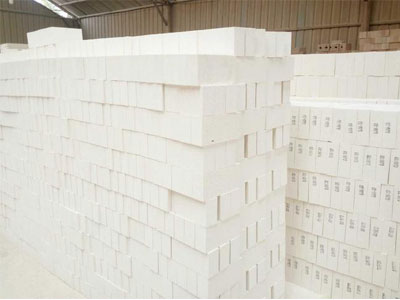Heat-insulating refractory materials refer to refractory materials with high porosity, low bulk density, low thermal conductivity and certain insulation effect. Due to the light weight of heat-insulating refractory materials, they are usually called lightweight refractory materials
1. Introduction of commonly used thermal insulation refractory materials
1. Fibers: vacuum insulation panels, ceramic fiber blankets, cotton, felt, threads, etc.
2. Refractory bricks: lightweight refractory bricks, lightweight high alumina bricks, lightweight clay bricks
3. Castables: lightweight high-aluminum castables
There are many types of thermal insulation refractory materials, so let’s briefly introduce them:
1. Vacuum insulation panel
1.1 Characteristics of vacuum insulation panel:
(1) Convenient construction, light weight and cost saving
(2) High temperature resistance, high compressive strength and long service life
(3) Good heat insulation performance at high temperature
(4) Good thermal shock stability and high mechanical strength
2. Ceramic fiber products
3. Lightweight refractory bricks
3.1 Characteristics of lightweight refractory bricks:
(1) Small density, high porosity, light weight
(2) Low thermal conductivity and good thermal insulation performance
(3) Cost-effective and widely used
3.2 Physical and chemical indicators of lightweight refractory bricks
2. The performance of heat insulation refractory materials
1. The bulk density is small, the distribution of pores is large, the porosity is high, and the thermal conductivity is small.
2. The thermal insulation material has stable performance, has a clear thermal conductivity, and has a wide range of applicable temperatures.
3. Good chemical stability, no corrosion.
4. Good waterproof performance and low hygroscopicity.
5. Difficult to burn and fireproof, small combustible components, non-combustible or self-extinguishing.
6. Good thermal shock resistance.
7. Easy processing and convenient construction.
3. Working principle of heat insulation refractory materials
Industrial kilns built with general refractory materials usually have a low energy utilization rate, and thermal conductivity is an essential data for the design of high-temperature thermal equipment. Increasing the use of thermal insulation materials to build kilns can reduce the heat loss of walls , Improve thermal efficiency, increase thermal equipment output, reduce energy consumption, and work more economically and effectively.
4. Application range of heat insulation refractories
Insulating refractory materials are used in heating furnaces (furnace wall, furnace bottom and furnace roof), open hearth furnaces, heat treatment furnaces, coking furnaces (combustion chambers, regenerators), annealing furnaces, quenching furnaces, etc. in metallurgy, petrochemical, machinery, electronics and other industries The inner lining of the kiln and the outer layer of the refractory layer are used as thermal insulation materials for various high-temperature pipelines, and can also be used as high-temperature sealing materials. It can also be specially used for the heat insulation layer and insulation layer of thermal equipment. Good quality heat preservation refractory materials can replace ordinary dense refractory masonry, which can save energy consumption and reduce construction costs.
5. The service temperature of heat insulation refractory materials
6. Classification of heat insulation refractory materials
1. According to the use temperature:
(1) Low temperature heat insulation materials, the use temperature is lower than 900 ℃, such as diatomite heat insulation bricks, asbestos, expanded vermiculite and slag wool, etc.;
(2) Medium-temperature insulation materials, the service temperature is 900~1200℃, such as expanded perlite, lightweight clay bricks and refractory fibers, etc.;
(3) High-temperature insulation materials, the service temperature is 1100°C-1500°C, such as light heat-insulating high-alumina materials, lightweight corundum bricks, hollow ball products and high-temperature refractory fiber products, etc.
2. According to volume density:
(1) General heat insulation materials, the bulk density is between 0.3-1.3g/cm3;
(2) Ultra-light heat insulation material with a bulk density of less than 0.3g/cm3.
3. According to the shape of the material:
(1) Powder granular insulation materials: expanded perlite, alumina powder, lightweight castables, lightweight refractory concrete
(2) Shaped insulation material: lightweight refractory
(3) Fibrous insulation materials: asbestos, glass fiber, ceramic fiber
(4) Composite insulation materials: insulation board, insulation coating
4. According to the manufacturing method:
(1) Porous products by raw material method: that is, products made of porous materials, such as diatomite and its products;
(2) Light raw material products by burning out addition method: add combustibles to the legally made products, add sawdust, carbon powder and other things that are easy to burn out into the mud, so that the sintered products have a certain porosity, mainly light silicon ;
(3) Foam method porous lightweight products: porous products made of foam, foaming agent is added to the mud and processed by mechanical methods to make porous lightweight refractory products.
(4) Porous products made by chemical method: products made by chemical method, carbonate and acid, caustic alkali or metal aluminum, etc. are added to the mud, and the product is formed by the gas generated by chemical reaction to form pores.
5. According to chemical mineral composition or production raw materials:
Silica, clay, high alumina, magnesia, diatomaceous earth, perlite, aluminum silicate fiber, alumina and other thermal insulation refractory materials.
7. How to choose a suitable heat insulation refractory material?
1. According to the operating temperature of the kiln.
2. The maximum service temperature of heat insulation refractory materials
3. Thermal insulation performance, including thermal conductivity, bulk density, specific heat, etc.
4. Economic benefits, including price, construction and durability.
8. Matters needing attention in the use of heat insulation refractory materials
1. It is forbidden to stack goods on the heat-insulating refractory material.
2. Put it in a dry and ventilated place, and do a good job of moisture-proof and rain-proof.
3. Reasonable use of heat-insulating refractory materials and construction methods with corresponding properties according to design requirements.
4. For cutting fiber products, use as needed, and do not tear at will.
High-efficiency heat-insulating refractory materials can not only bring users normal kiln operation, but also reduce heat loss, lower kiln operating costs, and slow down the erosion of the kiln lining.



